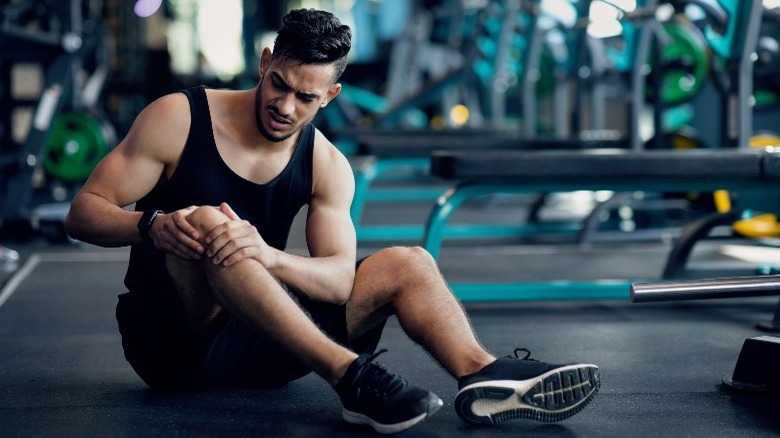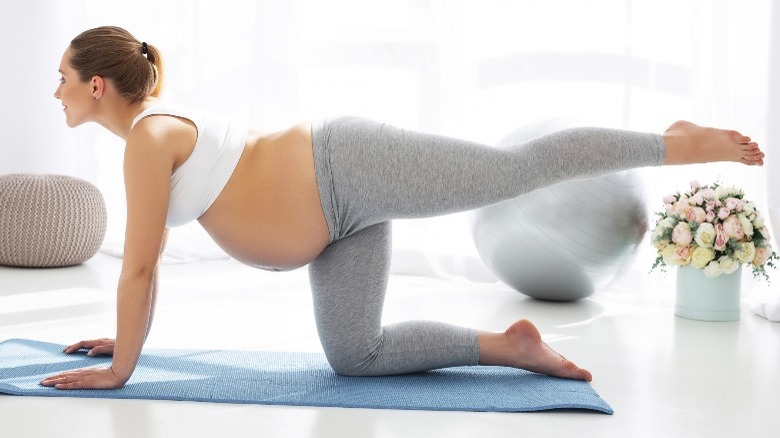Times You Should Avoid Doing HIIT Workouts
If you love a good HIIT workout, you're not alone. According to the MINDBODY 2020 Wellness Index, 10% of Americans reported attending a weekly HIIT class. An acronym for "high-intensity interval training," HIIT workout sessions are popular among those who want to challenge their muscles and cardiovascular system, per The New York Times. The HIIT approach involves intervals of strenuous physical exercises that incorporate running, hopping, jumping, and other short bursts of activity lasting up to several minutes, with pauses for rest in between.
While HIIT has its fans, there are also studies that highlight the drawbacks. Those who are pro-HIIT love how it's a way to get in maximized fitness for the day quickly, since you work harder for a shorter period of time. However, if you have certain health conditions, it is best to consult your doctor to discuss how you might want to modify your HIIT workout. And for people dealing with serious underlying health issues, it could be best to avoid HIIT workouts altogether, per Harvard Health.
So, how do you know when a HIIT workout is — and isn't — right for you?
HIIT may be dangerous for your heart
According to the experts at Johns Hopkins Medicine, cardiovascular exercise is great for your heart because it improves your heart muscle's ability to take in oxygen from your blood. It also can help to lower blood pressure and cholesterol.
However, aerobic exercise — especially the intense bursts that are a part of HIIT workouts — also puts more stress on the heart, which is not ideal for some. For instance, one study published in Current Treatment Options in Cardiac Medicine indicated that high-intensity exercise could increase the risk for certain heart conditions, especially for those who already have cardiac issues.
If HIIT workouts are not for you because of heart risks, that doesn't mean you shouldn't engage in cardiovascular exercises at all. Talk with your healthcare provider about a safe and healthy exercise regimen, but experts say that even if you are dealing with heart disease that exercise is still important, per MedlinePlus. They suggest starting slowly with activities such as swimming, walking, or bike riding. Just make sure to stretch beforehand, cool down afterward, and allow yourself to take rests in between, especially when you feel tired.
Be careful if you're new to exercise
Musculoskeletal therapist Mitchell Robinson of Sycamore Health acknowledges that HIIT workouts have their benefits, but warns that if you're just beginning to exercise, HIIT is probably not going to be the best fit for you. This is because HIIT workouts can have complex movements and if you do them incorrectly, you can harm yourself. Robinson suggests trying less intense forms of physical activity first and working your way up to HIIT workouts.
However, if you are a beginner and still keen on trying a HIIT workout, Chris Ryan, C.S.C.S, a certified personal trainer, provided Shape with a HIIT plan to give newbies a taste. Ryan suggested that newcomers select two exercises per circuit. Start with an interval between 45 and 75 seconds for each exercise, rest, and then repeat the same circuit two more times. Decide on two more circuits of two exercises and follow the same protocol. Ryan stressed doing the exercise long enough that you get the form of the movement down. He also suggested adding light dumbbells to your second or third round or adjusting the interval time if you start feeling bored. Most importantly, Ryan cautioned against overdoing it and emphasized that you must give your body time to recover. He advised making HIIT part of a well-balanced workout routine that you mix up with other types of exercise throughout the week to avoid injury.
Don't do a HIIT workout if you're injured
And speaking of injuries, engaging in a HIIT workout is not advisable if you're hurt. The impact and speed of the exercises will only add more stress and pressure to your joints and muscles, according to Shelley Keating, Ph.D., a researcher at the School of Human Movement and Nutrition Sciences at The University of Queensland, Australia (per Livestrong). If you have an injury, you should select exercises that will be gentler on your body. Yuri Feito, Ph.D., associate professor of exercise science at Kennesaw State University, agreed, mentioning to Livestrong that having an injury doesn't mean you necessarily need to avoid beginning an exercise routine altogether. If your doctor approves, you may want to consider trying a modified HIIT workout or other types of exercises that don't put stress on the affected areas.
Depending on the nature of your injury, the experts at Amory Urgent Care offer some possible exercises you may want to consider, even as you are recovering. For instance, swimming or another form of workout in the pool can be a low-impact way to get in a full workout if you are dealing with an injury. They also advise keeping your blood flowing by performing exercises that require resistance bands to isolate muscles and work around the injury. For an injury related to muscle tightness, incorporating basic stretch poses in your daily routine can also provide health benefits.
Rest today if you did a HIIT workout yesterday
HIIT is not designed to be done every day. It's an intense workout, and so you need to give your body time to recover, despite how amazing you might feel after your HIIT workout. In general, allowing your body time to recover is an important part of any weekly exercise regimen and a key aspect of your fitness progress (per SELF). John Gallucci, Jr., physical therapist and president of JAG Physical Therapy told SELF that despite how important it is to give your muscles and tissue a chance to recover, many people neglect to give their body the rest it needs. Regarding HITT specifically, SELF advised only doing these types of workouts once or twice a week. HIIT is a full-body workout, so it is important to take a day off or at least engage in a lower-impact exercise the following day to allow your body time to rebuild. Jen Jewell, a certified personal trainer, told SELF she advises giving muscle groups anywhere from 24 to 48 hours of rest.
Whatever your workout routine, the experts at Medical News Today advise that you rest at least one day every seven to 10 days on a regular basis. You should give yourself permission to take even more rest if you experience pain, soreness, or sluggishness after your workout. These are signals from your body that it's time to give yourself a break.
It may be best to avoid HIIT workouts during pregnancy
The American College of Obstetricians and Gynecologists (ACOG) states that exercising does not increase any risks during pregnancy and suggests that pregnant women get 150 minutes of moderate-intensity aerobic activity on a weekly basis. In other words, it's okay for you to work out enough that you get your heart rate up and break a sweat.
While it is important to remain physically active during pregnancy, HIIT workouts may not be an ideal choice for those who are new to this kind of workout, per What To Expect. However, if you are pregnant and accustomed to doing HIIT workouts, keeping this as part of your fitness routine could provide benefits to you as well as your baby, such as reducing achiness and fatigue, among others. What To Expect advises that you get your healthcare provider's approval before you dive in. This will give you peace of mind that your plan is healthy. Make sure your instructor is also aware that you are pregnant and ask if they can provide modified movements, especially ones that avoid jumping and sudden changes in direction, to prevent any risks. You may find you have issues balancing, which is normal during pregnancy, so it is advisable to have a wall nearby. Also, hydration is super important, so take whatever breaks you need beyond what the HIIT instructor gives to get in those extra sips of water, per What To Expect.






